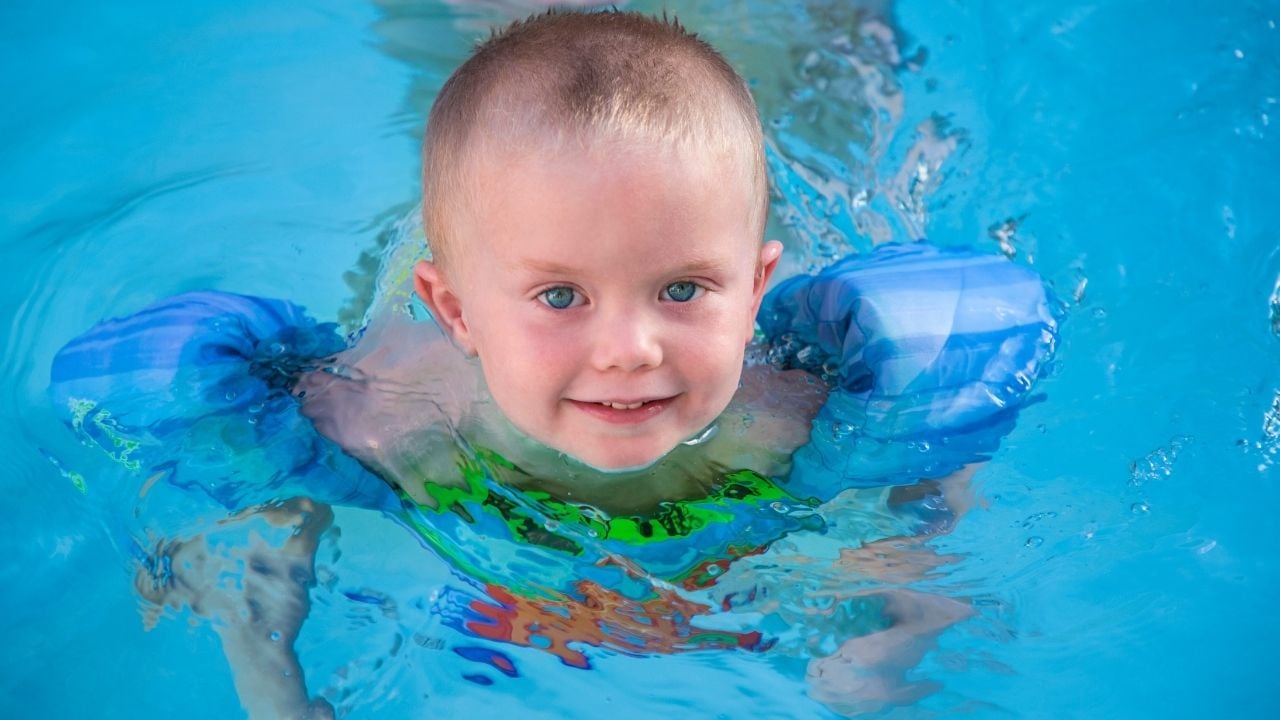
Puddle jumpers are practically a toddler and preschooler uniform at the beach or pool and it’s easy to see why these flotation devices—which also go by names like life vest and swim aid and are similar to a pair of water wings but with a vest attaching the two padded arms—are so popular. They’re not as bulky as a lifejacket making them easy to put on and more comfortable for the kid. They’re also usually brightly coloured or covered in beloved animated characters which makes kids want to wear them.
But, despite their popularity, puddle jumpers are actually really unsafe, say swim safety experts. There are a few issues here. One is their suitability as a flotation device. “I wouldn’t classify them necessarily as a toy, but they haven’t undergone the same kind of rigorous testing and they’re not made of the same material as a life jacket or a PFD,” says Pamela Fuselli, president and CEO of injury prevention non-profit Parachute, who notes they aren’t approved for boating use by Transport Canada.
Another issue is the position the vests put kids in in the water. Because of their design, the device puts swimmers in an upright position— head up, feet down and arms floating to the sides. This is actually referred to as the drowning position and is dangerous for kids to get comfortable in. “Kids will build muscle memory from being vertical and this is a very scary situation,” says Rishona Hyman, owner of Aqua Essence Swim Academy in Winnipeg. “If they forget to put [the puddle jumper] on or they fall in, they will revert to this position as it is all they know and then tragedy can strike.” Many parents have taken to the internet to say that they believe this drowning position—coupled with the false sense of security the puddle jumper gave their kid, contributed to their death.
So, what should you do instead of putting your kid in a puddle jumper? The first step is making sure your kids are comfortable in and around water. Fuselli recommends kids start learning to swim as early as lessons are available. Hyman adds that, “Parents should start teaching kids to swim at four to six months of age. Babies naturally know how to swim and it is an excellent way to start building skills, bonding with your baby and showing them how safe and fun water can be.”
Once your child has learned the basics of swimming and is comfortable around water, instead of using a puddle jumper, both Hyman and Fuselli recommend using a lifejacket whenever hands-on supervision is not possible. Unlike with puddle jumpers, if a child were to fall in the water, “a life jacket will actually turn [them] from face down to face up in the water,” says Fuselli. Life jackets also allow for kids to swim horizontally and get their legs up to kick, creating better swimming habits for when they start swimming without a flotation device. It is important to remember, however, that even if your child is wearing a lifejacket or is swimming with a different approved PFD, they should always be supervised. Depending on their skill level, this could either mean being in the water with them, or at an arm’s reach away.
When taking your kids swimming, keep these extra safety tips in mind:
- Put your kid in a brightly coloured swimsuit so they’re easy to spot in and out of the water. In a pool, your best options for visibility are neon pink and neon orange. In a lake, go for either neon yellow, neon green or neon orange.
- Make sure whoever is on supervision duty is aware they are on duty and are actively watching
- When supervising, don’t drink, go on your phone or engage in any other activity that could distract your from the kids
- Go over water safety with your kids before taking them swimming
- Remember, drowning is quick and silent. Even a quick glance away can lead to tragedy, so always be an active supervisor
- If you are going to be supervising kids around water, ensure that you yourself are a confident swimmer. It’s even recommended to take a course in CPR and standard first aid to be extra cautious
The post Why this popular flotation device could actually be really dangerous for your kid appeared first on Today's Parent.
